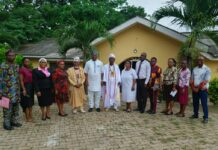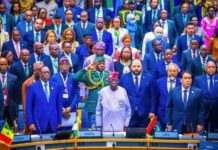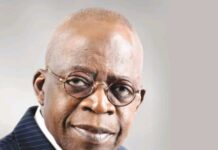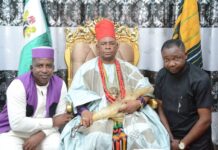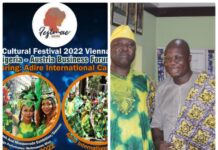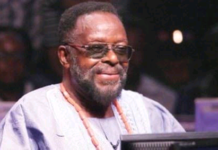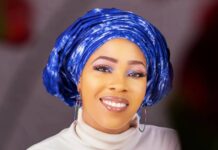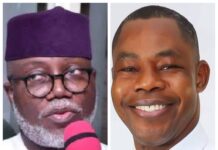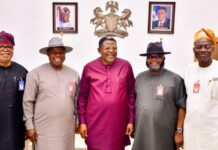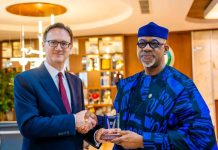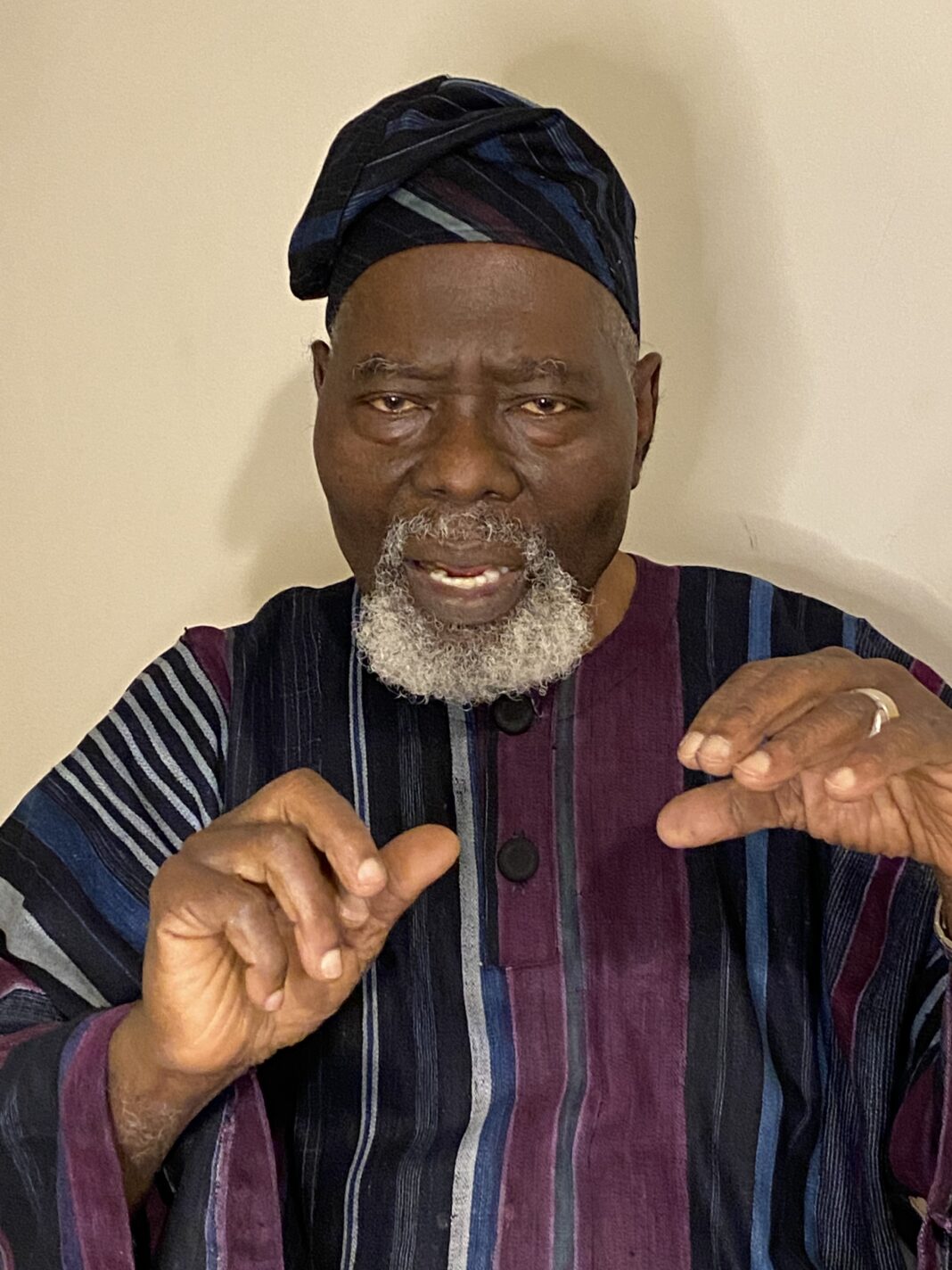Owo, Ondo State-born Rowland Abiodun is a professor of Art, History of Art, and Black Studies at John C. Newton’s Amherst College, Amherst, Massachusetts, United States of America. He authored ‘Yoruba Art and Language: Seeking the African in African Art,’ (2014); ‘What Follows Six Is More than Seven: Understanding African Art,’ (1995); and co-authored ‘Yoruba: Nine Centuries of African Art and Thought,’ (1989); Yoruba Art and Aesthetics,’ (1991); and ‘Cloth Only Wears to Shreds: Yoruba Textiles and Photographs from the Beier Collection,’ (2004). The co-editor of ‘The Yoruba Artist: New Theoretical Perspectives on African Arts, (1994). Abiodun was also a consultant for, and participant in the Smithsonian World Film, Kindred Spirits: Contemporary Nigerian Art. He also served as a former member and chair of the Herskovits Book Award Committee of the African Studies Association, ASA; and has also served on the Board of Directors of the ASA and as the President of the Arts Council of the African Studies Association. The erudite and well-travelled Arts professor also chaired the Executive Board of the Five College African Scholars Program, Amherst, Massachusetts, and has been interviewed by the BBC World Service on African art. In 2011, he received the Leadership Award of the Arts Council of the ASA in recognition of his excellence, innovative contributions, and vision in the fields of African and Diasporic Arts. Prof Abiodun shared with CompassNG as he celebrates his 80th birthday. Excerpts:
Congratulations on your 80th birthday. How has your upbringing shaped your vision as a scholar?
Thank you! In my eventual journeys within educational landscapes, far removed from those years sitting on the sand of the family courtyard in the moonlight, listening to stories and other verbal creativities, I took with me the intimate empowerments of an informal, yet potent form of family-centered oral learning – voices from a kind of knowledge that is not written anywhere except in the human mind and heart, yet resonant across time. Those voices, distant in time and space, but vibrant in my being, called out to me to represent them in my new worlds of knowledge – Western written epistemology, where they had no place.
What can you tell us about Yoruba civilization, disciplines, and your own work on Yoruba art?
Yorùbá civilization may be understood in terms of an interlocking network of disciplines, structured methods of understanding, exploring and shaping reality. These are sustained by particular epistemic frameworks, ideas about the nature of knowledge within the larger domain of Yorùbá discourse, carried forward through distinctive processes. These disciplines constitute Yorùbá knowledge capital, a cognitive development growing and changing across the centuries within a configuration building on older ideas and practices as new ones are developed. This knowledge capital was preserved and transmitted orally for centuries by a community of practitioners, and in its oral and newer written forms, it is increasingly extending beyond Yorùbáland into the Americas. In this regard, we must mention Akínwùmí Ògúndìran’s development of ideas of knowledge capital and community of practice in interpreting Yorùbá history, as well as Adélékè Adéẹ̀kọ́’s work on the arts of being Yoruba, which engages vigorously the fundamental question of how we define the Yoruba. My study of Yorùbá art has often centered on older, definitive forms of this culture in order to better understand its products, among the greatest in the world. The ideas thus unraveled, however, have profound consequences for thought generally, even beyond the arts with which they are directly associated. They implicate issues of the ultimate significance of expression, within and beyond speech and the visual and performing arts. They involve the intersection of aesthetics, metaphysics and ethics, engaging ideas about creativity and beauty, foundational meaning and how to live. This complex of values emerges from the resonance of the oral medium developed among the
Yorùbá with astonishing depth and diversity.
When and how did you develop interest in the interrelationship of Yoruba language and the arts?
In my family, and at many cultural events, I treasured Yoruba language, especially when words were used with finesse and ideally with discretion, and in sensitivity to their creative force. I observed my paternal grandmother, Yeye Ọlákòlí’s incredible knowledge of herbs and her mastery of their medicinal use for her midwifery work. I was exposed to the verbal creativity of my grandfather’s hunting guild members. I witnessed, on several occasions, my aunt’s casting of divination instruments, accompanied by verbalized incantations, ritual poetry and symbolic narratives, on issues affecting myself, reassured me of success in my endeavors. I could not help but be shaped by this universe of charged oral force, not being sensitive to the reality creating power of language as projected through orality.
I was surrounded by artistically gifted relatives and knowledge practitioners.
My paternal aunt, Yeye Oko, was an expert cloth dyer and herbalist, the natural color of whose hands I never saw growing up, because they were always covered with blue indigo dye. That is the source of my love of the sight and smell of indigo-dyed cloth, which remains to this day.
Yeye Dékẹ́, another aunt, practiced Ẹ̀ẹ̀rìndínlógún (16-cowrie) divination. I watched her perform divination for clients, thereby learning a few things about the principal Odù permutations (symbolic patterns and information carriers in this divinatory system), and their interpretations. This early exposure to Yorùbá divination underlies my life long work on Ifá, the divinatory complex to which Ẹ̀ẹ̀rìndínlógún belongs.
My participation, though passive, at these divinatory sessions, led me to appreciate them as exemplars of speaking, listening and gesture as epistemic activities. This appreciation, in turn, motivates my studying them through the oral contexts in which they are performed in order to understand how the oral, the visual and the performative cohere in constructing the Yorùbá knowledge cosmos.
My paternal grandmother, Ọlákòlí, in addition to being a traditional mid-wife, was also an expert dyer. My paternal uncle, Ògúnlẹ́yẹ Ọlọ́gán, at Ùṣèlú in Ọ̀wọ̀, was a renowned blacksmith and wood-carver of Àkó (second burial effigy in Ọ̀wọ̀), a practice that has inspired a few publications in academic journals and a chapter in my 2014 book. Another aunt, Adérẹ̀nlúkò, was an expert cloth weaver. I have co-curated an exhibition and written a catalog on Yorùbá arts of cloth as well.
My active participation in these artistic worlds began with my occasional performances in an Ọ̀wọ̀ children’s masquerade, called “Ìjàmjà.” Solely for entertainment, we went from house to house, dancing to music produced by our peers and collected a few pennies, and sometimes food items, which we shared at the end of the performance. Immersion in this embodied artistic and cognitive universe predisposed me to the practice and study of Yorùbá arts and their embedding in rich worlds of knowledge. The sonority of the Yorùbá language remains with me even after decades spent in the United States. Its corridors of sonic resonance, its architectures of evocative meaning grounded in verbal permutations remain fundamental to my identity. They are central to my becoming an ardent student of the spoken word in Yorùbá.

Where in Yorubaland has your research taken you, besides Owo, your birthplace and how has your research work benefitted your students and maybe the discipline of African art history in particular?
My quest for cultural education took me to other Yorùbá towns, among them, Oǹdó, Ilẹ̀-Olújì, Ìjerò-Èkìtì (my mother’s hometown), Ìdànrè, Òkìtìpupa, Màhín, Ẹdẹ, Òṣogbo, Ìbàdàn, Ọ̀yọ́, Ìmodi-Mọsàn, Ìjẹ̀bú-Òde and Ìbóorò (near Abẹ́òkúta). In most of these places, I spent at least three days in observing and sometimes participating in their ceremonies and rituals, all of which utilized visual and verbal arts, journeys whose insights I extracted into my work.
Perhaps the most challenging but rewarding chapter of my academic life at Ifẹ̀ was when I accepted in the mid-1980s, with the encouragement and support of Professors Ọlábíyì Yáì, Sopé Oyèláràn, and Akin Ìṣọ̀lá in the Department of African Languages and Literatures, chaired by Wándé Abímbọ́lá, to teach Yorùbá art entirely in Yoruba language. This meant putting into practice what I had always preached. This exercise proved for me the quintessential role of language in understanding and teaching Yorùbá art – in particular, the interdependence of the verbal and visual arts through oríkì. These experiences were high points of my life. In 1994, a prominent Yorùbá language scholar, Olabiyi Yai, argued persuasively that “when approaching Yorùbá art, an intellectual orientation…consonant with Yorùbá traditions of scholarship would be to consider each individual Yorùbá art work and the entire corpus as oríkì.” While oríkì has been generally translated as “praise poetry” or “citation poetry,” broadly speaking, all verbal and visual invocations qualify as oríkì in Yorùbá culture. Oríkì affirm the identity, the essence of almost everything in existence, every
object of consciousness. Oríkì extends beyond the categories of two- and
three-dimensional arts and color to include architectural space, dress, music, dance, the performed word, mime, ritual, smell, and food, engaging all the senses. This definition of Yorùbá art suggests an interdependence of the verbal and visual arts through the concept of oríkì – evidence of the well-acclaimed richness of their oral culture. The study of oríkì in relation to Yorùbá art is not unlike what scholars do in Western art history, when they seek to deepen their understanding and appreciation of their subject. They look at its intimate connections with, and relationship to language, canonical literature and culture. It is expected that a scholar of French Impressionism be proficient in the French language, read relevant literature in French, and have a good knowledge of French culture. The same language requirements apply to
scholars of Japanese or Chinese art in order to make their work credible and noteworthy. Because proficiency in African languages has not been generally considered a prerequisite for research in African art history, the critical place of these languages have never really been discussed in the methodology, conceptual
frameworks and analysis of most Africanist art scholarship. It is also possible that the origins of the low priority given to African languages in African art studies lie in the attitude of colonialists, who often regarded African languages as inferior in status to Western languages, and therefore unfit for use in serious academic discourse. This attitude influenced the decisions of early Africanist art scholars and even many colleagues who, today, still conduct their research entirely in Western languages or through translators, who might not possess the requisite linguistic training to perform the tasks expected of them.
It was predictable that with time, many would drift more towards studying African art solely through the colonizers’ languages and not through the
languages of the creators and users of this art. Though using a foreign language seems to guarantee a kind of temporary space for African art in the art historical marketplace, there is a real danger that Africa’s intellectual contributions through African languages to the study of art in the world might be lost forever. My work explores new, holistic perspectives for the critical interpretation of African art as exemplified by the interrelationship of the visual and verbal arts among the Yorùbá of West Africa. Without the appropriate epistemological “key,” the door may remain locked even to the finest of scholars in African art.
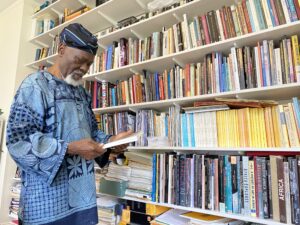
Is the oríkì theory useful to the study of art in non-Yoruba African societies?
Equivalents of Yorùbá oríkì in their visual and verbal forms abound among many African peoples and their descendants in the diaspora, even if they do not use the same terms. The fact that, among the Yorùbá, oríkì is immensely important as an efficient means of capturing moments or nuggets of history that provide an indispensable body of research material for reconstructing artistic values, makes oríkì and oríkì-type phenomena not an option, but a necessity in African art historical methodology.
We are still experiencing brain drain in Nigeria and this is affecting our
academic sector adversely. What is your take?
Brain drain has been caused by certain identifiable conditions. Would it not make sense to address those conditions first and foremost? I believe very strongly that most, if not all, Nigerians abroad love their country and would gladly return home, if the conditions that caused their departure are addressed.
Thank you for sharing your knowledge with us.
You are most welcome!




